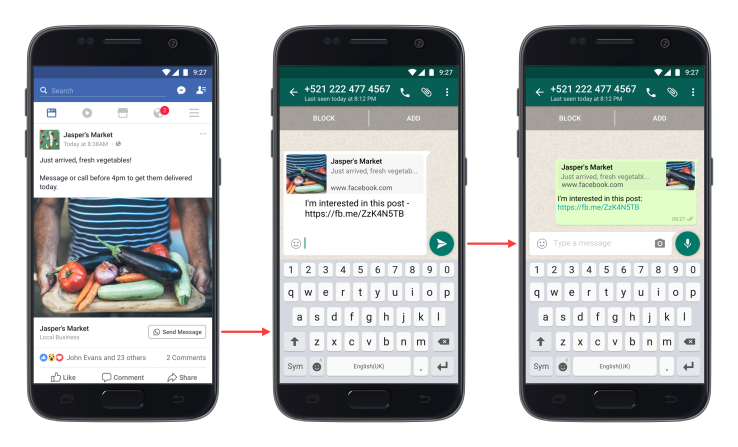

WhatsApp has always said that it has no plans to put ads into its own app, but this is not stopping Facebook, which now owns WhatsApp, from figuring out other ways of monetizing the hugely popular messaging service, which has around 1 billion daily users.
Today, Facebook is launching a new ad unit that will let businesses create a link between the two platforms: advertisers can now include a button on their ads so that people can call or message via WhatsApp with the click of a button.
 We reported early sightings of the feature in test mode earlier this year. Now, Facebook has confirmed to us that it’s rolling this out gradually, starting first with North and South America, Africa, Australia and most of Asia.
We reported early sightings of the feature in test mode earlier this year. Now, Facebook has confirmed to us that it’s rolling this out gradually, starting first with North and South America, Africa, Australia and most of Asia.
You might notice that Europe is not included in the list, and wonder if that might relate to news that Facebook last year had to pause efforts to share data between the two platforms when it was deemed to violate data protection laws.
From what we understand, the plan is to introduce Europe at a later date, but Facebook is going to first observe how the feature is used elsewhere, and is also still working through questions from outside the company about how WhatsApp and Facebook will work together.
(Those outside the company may well include consumers, but also regulators.)
The new feature getting announced today, more generally, follows on from some bigger developments for how WhatsApp is already being used by businesses.
Facebook tells us that more than 1 million Facebook Pages already include WhatsApp numbers in their posts each month, which implies that there is already a pipeline between the two companies being used by businesses more informally to connect with customers more directly.
Anecdotally, I’ve heard that in some developing markets, businesses are using their WhatsApp and Facebook pages as their primary points of contact for users, so this would make some sense to expand for Facebook, as the new White and Yellow Pages, respectively.
“Many people already use WhatsApp to communicate with small businesses. It’s a fast, convenient way to stay in touch,” said Pancham Gajjar, product marketing manager, Facebook, in a statement. “By adding a click-to-WhatsApp button to Facebook ads, businesses can now make it even easier for people to learn about their products, set up an appointment or use their service.”
The other trend to note here is that WhatsApp has been working on a way of creating more specific business accounts for some time now. Most recently, it’s posted some more information on its help pages about how business accounts will be verified, confirmed or unconfirmed — although it has yet to roll out any specific products or pricing tiers that speak to these three statuses.
The new button ad-unit is also similar to the click-to-Messenger ads that Facebook previously rolled out.
“That format was the first ad product to explicitly link activity on Facebook with activity on Messenger, and it was followed by other ad formats on Messenger itself,” said eMarketer principal analyst Debbie Williamson. “It seems that Facebook is following a similar strategy for WhatsApp, starting with click-to-WhatsApp ads on Facebook, and presumably eventually rolling out ads on WhatsApp itself.” (Which really would be a track back from WhatsApp’s mission statement.)
For now, Facebook does not have plans to add the WhatsApp button integration to regular consumer services, although you can see the potential for putting the links in, say, Pages where users want to offer a contact address, or in the Marketplace next to items that are being sold, or even in job listings.
“We recently started testing different ways for a Facebook Page to point people to their WhatsApp presence from the Page itself,” a spokesperson said, “but don’t have any more details to share on that right now.”
Updated with comment from eMarketer.

